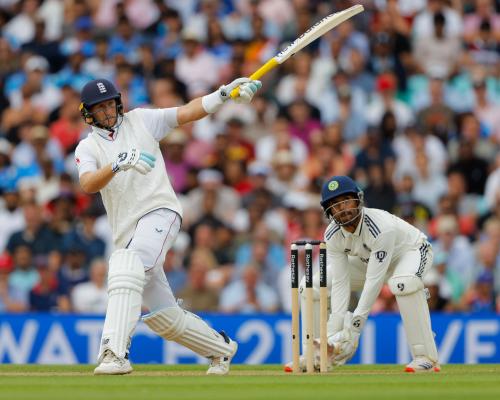
Joe Root shifts his weight forward, rising with the lifting ball from back of a good length. As it nears his body he moves his hands and bat towards the ball. In one seamless motion, with the ball under his eyes, he adjusts his weight back a touch, twisting his wrists to open the face of the blade. He lets the ball come to him before directing it through the gap between gully and third slip.
That’s a lot of words to say that Joe Root has yet again steered one behind square for four.
Or did he guide it? Or caress it? Or dab it? He certainly didn’t lash it or drill it. It’s just a touch. The merest of deflections. A gentle kiss. It’s become the Joe Root staple, the perfect embodiment of a supremely gifted athlete in complete control of his universe.
When you’re on the Guardian’s over-by-over commentary you need a catalogue of verbs in your head to serve as shorthands, especially when someone like Ravindra Jadeja is hurtling through his overs. Stephen Fry compiled a list of more than 100 words that can be used to describe the action of hitting a ball. There are the simple ones; your pokes, your whacks, your slogs. But every now and then you might want to get a little funky and use your platform to flex your repertoire. Caution, though, is required.
“Occasionally you say something that doesn’t quite land,” explains the BBC’s Test Match Special commentator, Daniel Norcross. “One I like to use is ‘strapple’, which I think best explains the straight pull shot with a cross bat that goes past the bowler. Another is ‘greeble’, which is when a batter, usually a lower order one, uncontrollably squirts one off the outside edge for a single past gully, infuriating the bowler. These aren’t real words but they make sense if you understand how a batter moves in the crease.”
Some players are synonymous with certain descriptors. It is said that Alastair Cook amassed 12,472 Test runs with little more than a nudge off the hips, not to be confused with Graeme Smith’s muscular biffs. Brian Lara flayed and scythed at any width outside the off stump while Robin Smith, according to Norcross, “savaged short balls with sheer violence”.
By using verbs that evoke everyday actions – pummelled over square leg, dribbled past point – commentators and bloggers are able to circumnavigate the need to dumb down the rhetoric in an attempt to make the narrative more accessible. Even non-cricket tragics could conjure up an image when I report that Aiden Markram had just smoked one past cover off the front foot. Perhaps the sight of his high elbow, his weight leaning over a bent front knee and the arcing bat through the air remain elusive. But the velocity of the ball cannoning through the infield is instantly apparent.
“Cricket offers so much room for creativity,” says Henry Moeran of the BBC. “Unlike baseball, where every shot is more or less carried out in the same fashion, cricket has this three dimensional aspect to it. Different types of bowlers and pitches warrant different shots and each shot is played out in their own unique way. A player can loft a ball into the on-side but if they don’t quite time it they spoon it. A prod isn’t quite as forceful as a bunt. A tickle down to fine leg is perhaps finer than a tuck off the pads. A steer is more controlled than a chop.”
But this isn’t just about flair or flourish. Culture shapes cricket’s vocabulary too. Philasande Sixaba is a broadcaster in South Africa who specialises in isiXhosa commentary. He learned the game on the slower decks of his native Eastern Cape but cut his teeth on the bouncy surfaces of Johannesburg, where cuts and pulls were held in higher regard.
“If you can hit a fast bowler off the back foot on the Highveld you’re a serious player,” Sixaba explains. “So naturally, when I’m commentating or even talking about cricket with my mates, I get excited when I see someone cut or pull. And then when I add the isiXhosa element to it, it takes on a new meaning.
“For example, when a batter is lazy at a wide ball we say, ‘ulahla izandla ebholeni’ which means you’re giving up on the ball, even though you’re still chasing the ball with your hands away from your body. Another one is, ‘ukwela ematini’ which roughly translates to dancing down the mat. The mat is the pitch and is a reference to the time where black people in the country could only play on matted surfaces. It’s a nod to where we’ve come from and carries importance to this day.”
Some shots even evolve into adjectives in their own right. A flick is always wristy. A hoick is agricultural. You scoop from one knee as if digging a hole on the beach. A punch is firm and straight, like a robust argument. The scoreboard offers facts and the wagon wheel offers shapes, but it’s language that gives cricket its colour. Feathers to deep third, thrashes through the covers, mows towards cow corner and fine laps over the fielder at 45. We’ve turned individual strokes into stories, morphing a game of numbers into one of poetry.
Hussain looks at big picture after classic
In the immediate afterglow of one of the greatest Test series ever played, Nasser Hussain was still conscious of the big picture. Less than an hour had passed since Mohammed Siraj uprooted Gus Atkinson’s off-stump at the Oval to claim a six-run win for India and draw the Anderson-Tendulkar Trophy. Most commentators and pundits were still trying to make sense of it all. Hussain was note-perfect.
“It would be lovely to just look at this here this week and wonder why we complain about Test cricket,” the former England captain said on Sky Sports’ coverage. “I have turned up every day this series and thought, ‘Why do people knock this format? It is just so wonderful’.
“But I’m afraid not every country has the luxuries and the luck that we have. So we, and India and Australia, have to keep an eye out for the future of Test cricket. If we let this go we are not doing the game a service. We have to keep pushing it forward and look after those who are not as fortunate.”
This wasn’t some guff about world peace delivered by a beauty pageant winner. This was one of the most influential voices in the game calling for perspective. This England-India series was an epic precisely because it stretched across five Tests. It challenged the depth of both squads, pushed players to the limit and provided enough scope for undulating narratives across a summer.
South Africa, the current world champions of the format, last played a five-match series in 2005. The West Indies last did so in 2002. For Pakistan it is 1987 while New Zealand, Sri Lanka and Bangladesh have never had the privilege.
This is not to say that every nation should by right be afforded so much cricket. They probably would reject the offer given the costs involved. But Hussain’s broader point still stands.
Test cricket could theoretically survive if only three teams played it, but what a shame that would be. The boards of the Big Three need to recognise that a rising tide lifts all. That they have the power to change the world, that by sharing the wealth they have accumulated they might ensure that days like Monday at the Oval are not solely seen in just three countries.
Oscillating series that expand beyond two-Test shootouts are an absolute joy. More people should get to experience them.
Quote of the week
If someone gets injured that’s tough shit” – Ben Stokes makes it pretty clear where he stands on substitutions for injured players in cricket.
Memory lane
To Kingston, Jamaica, in January 1998 as John Crawley and Mark Butcher play guitars at the memorial statue of Bob Marley. England were there for a tour of West Indies, but the first Test would be infamously abandoned at Sabina Park. As Alec Stewart later recalled: “Mark Butcher hadn’t faced a ball on tour and his first ball hit the handle of his bat and flew to slip.” As fans of the past week may recognise, the match lasted 56 minutes; West Indies went on to win the series 3-1.
Still want more?
Barney Ronay takes a look back on the drama and beauty that was the England v India Test series.
Thoughts now turn towards the Ashes, with Ali Martin focusing on the importance of a certain Ben Stokes as a true all-rounder to keep the tourists competitive.
And Taha Hashim reports on the return of the Hundred, with a double-header at Lord’s between the London Spirit and Oval Invincibles men’s and women’s teams, which included a surprise guest.



